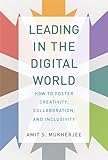Leading in the digital world : how to foster creativity, collaboration, and inclusivity / Amit S. Mukherjee.
Material type: TextLanguage: English Series: Management on the cutting edge | Management on the cutting edgePublisher: Cambridge, Massachusetts : The MIT Press, [2020]Description: xiii, 205 pages : illustrations ; 24 cmContent type:
TextLanguage: English Series: Management on the cutting edge | Management on the cutting edgePublisher: Cambridge, Massachusetts : The MIT Press, [2020]Description: xiii, 205 pages : illustrations ; 24 cmContent type: - text
- unmediated
- volume
- 9780262043946 (hardcover)
- 0262043947 (hardcover)
- 658.4/092
- HD 45 M953l 2020
| Item type | Current library | Home library | Collection | Shelving location | Call number | Copy number | Status | Date due | Barcode |
|---|---|---|---|---|---|---|---|---|---|
 Libro
Libro
|
Biblioteca Juan Bosch | Biblioteca Juan Bosch | Ciencias Sociales | Ciencias Sociales (3er. Piso) | HD 45 M953l 2020 (Browse shelf(Opens below)) | 1 | Available | 00000150201 |
Includes bibliographical references and index.
"The twentieth century was marked by an emphasis on productivity-how to make more widgets efficiently. The best leaders were those who successfully managed for productivity, embracing such philosophies as Six Sigma and Quality Circles (such as those proposed by W. Edwards Deming in our own books Out of the Crisis and The New Economics). The twenty-first century is about a different kind of work-knowledge work-and as a result, needs a different emphasis. Rather than focusing on being productive, firms in the digital era need to focus on being creative. Creativity, as Amit Mukherjee defines it is 'the ability to look past received wisdom and traditional approaches to give form or structure to new ideas.' Just as the nature and goals of work are evolving, so too are the skills a leader needs to succeed. Before, leaders commanded hierarchical organizations. Now, technology is able to radically restructure hierarchical organizations into flatter, more collaborative environments, often drawing in workers from around the world. Academic models of leadership have been slow to reflect these changes. This book provides a framework for thinking about how to be a leader in the digital era. Instead of decreeing lists of 'five things to implement immediately,' it addresses the mindsets, behaviors, and actions that current and aspiring leaders should embrace. The book puts forth the idea of a 'Producing Leader,' (as opposed to earlier models of Facilitating or Directing Leaders). A producing leader has a broad knowledge base, creative vision, and uses empathy to make connections between groups of experts who ask for and give help. The book suggests ways that leaders can better create and support more inclusive working environments, and offers new ways of thinking about collaboration between firms (essential in today's world where Apple wouldn't be able to produce iPhones without Corning's Gorilla Glass). It also discusses the importance of setting and communicating values and strategic intentions to help mobilize and encourage workers to achieve firm-level goals. The book concludes with a guide to developing one's own personal leadership philosophy to enable the shift from leading for productivity to leading for creativity"-- Provided by publisher.


There are no comments on this title.